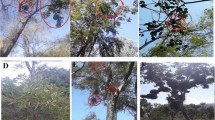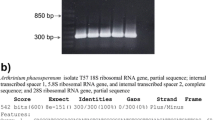Abstract
Monochasma savatieri Franch. ex Maxim is a perennial herb used in traditional Chinese medicine. In this study, we report on the semi-parasitism of M. savatieri for the first time and identify mosses (Hypnum plumaeforme and Funaria bygrometrica) as the primary host as well as 25 secondary host species. This species is well-suited to a subtropical hill and mountainous moist monsoon climate and grows well in hilly and sunny terrains. The anatomy of its semi-parasitic haustoria was also studied. A single strand of straight vessels branches out, and curved vessels are connected to the stele of the parent plant root rather than to the parent root directly. This might assist with the absorption of nutrients and can prevent backflow of nutrients. M. savatieri is becoming rare or even extinct in many areas. An understanding of the basic biology of this species, in particular the functioning of its haustoria, would enable further studies on its conventional as well as in vitro propagation.





Similar content being viewed by others
References
Bennett JR, Mathews S (2006) Phylogeny of the parasitic plant family Orobanchaceae inferred from phytochrome A. Am J Bot 93:1039–1051
Bolliger M (1993) Systematics and chorology of the genus Odontites ludwig S.I. (Scrophulariaceae). Flora 188:345–365
Bolliger M, Molau U (1992) Nothobartsia, a new genus of Scrophulariaceae from Southwest Europe. Plant Syst Evol 179:59–71
Echlin P (2009) Handbook of sample preparation for scanning electron microscopy and X-ray microanalysis. Springer, New York
Environment Agency of Japan (ed.) (2000) Threatened wildlife of Japan, Red data book. In: Environmental Agency of Japan (ed.), Vascular plants, 2rd edn., 8, Japan Wildlife Research Center, Tokyo, p 660
Gibson CC, Watkinson AR (1989) The host range and selectivity of a parasite plant, Rhinanthus minor L. Oecologia 78:401–406
Gibson CC, Watkinson AR (1991) Host selectivity and the mediation of competition by the root hemiparasite Rhinanthus minor. Oecologia 86:81–87
Hong D, Yang H, Jin C, Holmgren NH (1998) Scrophulariaceae. In: Wu ZY, Raven PH (eds) Flora of China, vol 18. Science Press and Missouri Botanical Garden Press, Beijing, pp 211–212
Joel MD, Gressel J, Musselman JL (2013) Parasitic Orobanchaceae: parasitic mechanisms and control strategies. Springer, Berlin
Johnson HB (1975) Plant pubescence, an ecological perspective. Bot Rev 41:233–258
Kaplan AE, Inceoglu O (2003) Leaf anatomy and morphology of 14 species belonging to the Turkish Rhinantheae (Scrophulariaceae) tribe. Isr J Plant Sci 51:297–305
Kohda H, Tanaka S, Yamaoka Y, Yahara S, Nohara T, Tanimoto T, Tanaka A (1989) Studies on lens-aldose-reductase inhibitor in medicinal-plants. 2. Active constituents of Monochasma savatieri Franch. ex Maxim. Chem Pharm Bull 37:3153–3154
Kuijt J (1964) Critical observations on the parasitism of New World mistletoes. Can J Bot 42:1243–1278
Kuijt J (1977) Haustoria of phanerogamic parasites. Ann Rev Phytopathol 15:91–118
Li M, Shi MF, Liu YL, Xu QM, Yang SL (2012) Phenylethanoid glycosides from Monochasma savatieri and their anticomplement activity through the classical pathway. Planta Med 78:1381–1386
Liu YL, He WJ, Mo L, Shi MF, Zhu YY, Pan S, Li XR, Xu QM, Yang SL (2013) Antimicrobial, anti-inflammatory activities and toxicology of phenylethanoid glycosides from Monochasma savatieri Franch. ex Maxim. J Ethnopharmacol 149:431–437
Ma J, Xu QM, Wu WQ, Liu CY (2012) Chemical constituents of active fractions of Yanning granules. Chin Tradit Pat Med 34:1946–1948 (in Chinese)
Mauricio R, Rausher MD (1997) Experimental manipulation of putative selective agents provides evidence for the role of natural enemies in the evolution of plant defense. Evolution 51:1435–1444
McNeal JR, Bennett JR, Wolfe AD, Mathews S (2013) Phylogeny and origins of holoparasitism in Orobanchaceae. Am J Bot 100:971–983
Musselman LJ, Dickinson WC (1975) Structure and development of haustorium in parasitic Scrophulariaceae. Bot J Linn Soc 70:183–212
Olmstead RG, De Pamphilis CW, Wolfe AD, Young ND, Elisons WJ, Reeves PA (2001) Disintegration of the Scrophulariaceae. Am J Bot 88:348–361
Piehl MA (1963) Mode of attachment, haustorium structure, and hosts of Pedicularis canadensis. Am J Bot 50:978–985
Rolls G (2008) 101 Steps to better histology. Leica Microsystems, Melbourne
Scheunert A, Fleischmann A, Olano-Marin C, Brauchler C, Heubl G (2012) Phylogeny of tribe Rhinantheae (Orobanchaceae) with a focus on biogeography, cytology and re-examination of generic concepts. Taxon 61:1269–1285
Shi MF, He WJ, Liu YL, Li XR, Yang SL, Xu QM (2013) Protective effect of total phenylethanoid glycosides from Monochasma savatieri Franch on myocardial ischemia injury. Phytomedicine 20:1251–1255
Tho JH, Tae KH, Lee J, Kim JH (2006) An unrecorded species in Korea, Monochasma sheareri (S. Moore) maxim. ex Franch. et Sav. (Scrophulariaceae). J Plant Biol 49:336–338
Werker E (2000) Trichome diversity and development. Adv Bot Res 31:1–35
Wu HS, Wang LM, Xu CQ, Wei F, Wu HH, He XJ, Xu JH (2000) Studies on the anti-inflammatory and antipyretic effects of Yanning granules. Chin J Mod Appl Pharm 5:365–368 (in Chinese)
Yahara S, Nohara T, Kohda H, Shimomura K, Satake M (1986) Study on the constituents of Monochasma-savatieri Franch ex Maxim. J Pharm Soc Japan (Yakugaku Zasshi) 106:725–728
Yamazaki T (1993) Scorphulariaceae. In: Iwatsuki K, Yamazaki T, Bufford DE, Ohba H (eds) Flora of Japan, vol a. Smithsonian Institution Press, Kodansha, Tokyo, pp 358–359
Yang YZ (2009) Plantlet regeneration of Monochasma savatieri Franch. ex Maxim in vitro culture from inducing adventitious root. Plant Physiol Commun 45:693–694 (in Chinese)
Yang XY, Zhang XH, Teixeira da Silva JA, Liang KM, Deng RF, Ma GH (2014) Ontogenesis of the collapsed layer during haustorium development in the root hemi-parasite Santalum album Linn. Plant Biol 16:282–290
Young ND, Steiner KE, de Pamphilis CW (1999) The evolution of parasitism in Scrophulariaceae/Orobanchaceae, plastid gene sequences refute an evolutionary transition series. Ann Mo Bot Gard 86:876–893
Zhang XH, Teixeira da Silva JA, Duan J, Deng RF, Xu XL, Ma GH (2012) Endogenous hormone levels and anatomical characters of haustoria in Santalum album L. seedlings before and after attachment to the host. J Plant Physiol 169:859–866
Zheng W, Tan XQ, Guo LJ, Kong FF, Lu P, Ni DJ, Wang P (2012) Chemical constituents from Monochasma savatieri. Chin J Nat Med 10:102–104
Zhu YY, Li M, Chen Z, Xu QM, Li XR, Yang SL (2013) Chemical constituents from Yanning granules. Chin Tradit Pat Med 5:988–994 (in Chinese)
Acknowledgments
This work was supported by the National Natural Science Foundation of China (Grant nos. 31100498, 31270720 and 30972295).
Author information
Authors and Affiliations
Corresponding authors
Rights and permissions
About this article
Cite this article
Zhang, M., Chen, Y., Ouyang, Y. et al. The biology and haustorial anatomy of semi-parasitic Monochasma savatieri Franch. ex Maxim. Plant Growth Regul 75, 473–481 (2015). https://doi.org/10.1007/s10725-014-0010-1
Received:
Accepted:
Published:
Issue Date:
DOI: https://doi.org/10.1007/s10725-014-0010-1




